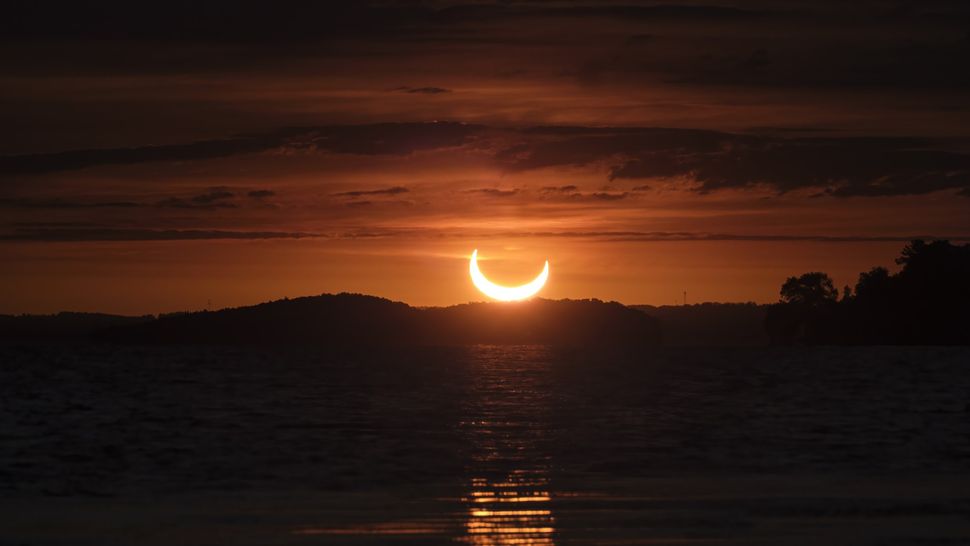
Have you ever seen the Sun sprout horns? On March 29, 2025, early risers in select parts of North America will witness a rare celestial spectacle: the “solar horns.” This phenomenon occurs during a partial solar eclipse, where the Sun appears as a crescent with pointed tips—resembling horns—just above the horizon at sunrise.Space
In this article, we’ll explore what causes the solar horns, where and when to see them, and how to view this event safely.
Understanding the ‘Solar Horns’ Phenomenon
What Are Solar Horns?
“Solar horns” refer to the visual effect during a partial solar eclipse when the Sun, partially obscured by the Moon, rises or sets. The overlapping of the Moon’s silhouette creates a crescent-shaped Sun with pointed ends, giving the illusion of horns protruding from the horizon. Gizmodo
Why Are They Rare?
This phenomenon is uncommon because it requires precise alignment:
-
The eclipse must occur during sunrise or sunset.
-
The observer must be located at a specific latitude and longitude where the alignment is visible.
-
Clear weather conditions are essential for visibility. Gizmodo+1NASA Science+1
When and Where to Witness the Solar Horns
Date and Time
The partial solar eclipse will occur on Saturday, March 29, 2025. In the northeastern United States and eastern Canada, the eclipse will be in progress during sunrise, offering the best chance to observe the solar horns. For instance, in Maine, the eclipse begins at 6:13 a.m. EDT and ends at 7:17 a.m. EDT .NASA Science+3YouTube+3Space+3Reddit+1People.com+1
Optimal Viewing Locations
The solar horns will be visible from:
-
Southeastern Quebec, Canada
-
Southwest New Brunswick, Canada
-
Northern Maine, USA Space
These regions lie between the St. Lawrence River estuary and the Bay of Fundy, where the alignment of the Sun and Moon will create the horned appearance at sunrise .Space
How to Safely View the Solar Horns
Observing a solar eclipse requires caution to protect your eyes. NASA Science+1People.com+1
Safety Tips
-
Use Proper Eye Protection: Always wear eclipse glasses that meet the ISO 12312-2 international safety standard. Regular sunglasses are not safe for viewing the Sun.
-
Avoid Direct Viewing: Never look directly at the Sun without proper protection, as it can cause permanent eye damage. The Sun+1NASA Science+1
-
Use Indirect Viewing Methods: Pinhole projectors or solar viewing boxes can project the image of the eclipse onto a surface, allowing safe observation.
Equipment Recommendations
For those interested in capturing the event:
-
Solar Filters for Cameras: Attach solar filters to camera lenses to photograph the eclipse safely.
-
Tripods: Use a stable tripod to keep your camera steady during long exposures.
The Science Behind the Solar Horns
A partial solar eclipse occurs when the Moon passes between the Earth and the Sun, but they are not perfectly aligned. This misalignment causes only a portion of the Sun to be obscured, resulting in a crescent shape. When this happens at sunrise or sunset, the atmospheric conditions and the angle of the Sun can create the illusion of horns. NASA ScienceTime
This specific event is notable because it coincides with the Moon’s perigee—the point in its orbit closest to Earth—making the Moon appear slightly larger in the sky .ScienceAlert
FAQs
Q: What causes the ‘solar horns’ during a partial solar eclipse?
A: The ‘solar horns’ appear when the partially eclipsed Sun rises or sets, and the overlapping of the Moon’s silhouette creates a crescent with pointed ends, resembling horns.
Q: Where can I see the solar horns on March 29, 2025?
A: They will be visible from southeastern Quebec and southwest New Brunswick in Canada, and northern Maine in the USA.Space
Q: What time should I observe the eclipse?
A: In the northeastern U.S., the eclipse begins around 6:13 a.m. EDT and ends by 7:17 a.m. EDT. The exact timing may vary based on your location. Reddit+2People.com+2The Sun+2
Q: Is it safe to look at the solar horns without protection?
A: No. Always use proper solar viewing glasses or indirect viewing methods to observe any solar eclipse safely.
Q: Will the solar horns be visible elsewhere?
A: While the partial eclipse will be visible in parts of North America, Europe, Africa, and Asia, the solar horns effect is specific to regions where the eclipse coincides with sunrise or sunset.
Conclusion
The March 29, 2025, partial solar eclipse offers a unique opportunity to witness the rare ‘solar horns’ phenomenon. For those in the northeastern U.S. and eastern Canada, this event combines the beauty of a sunrise with the awe of a celestial alignment. Remember to prioritize safety by using proper eye protection or indirect viewing methods.
Read our previous article: Our Solar System’s Place Among the Stars
